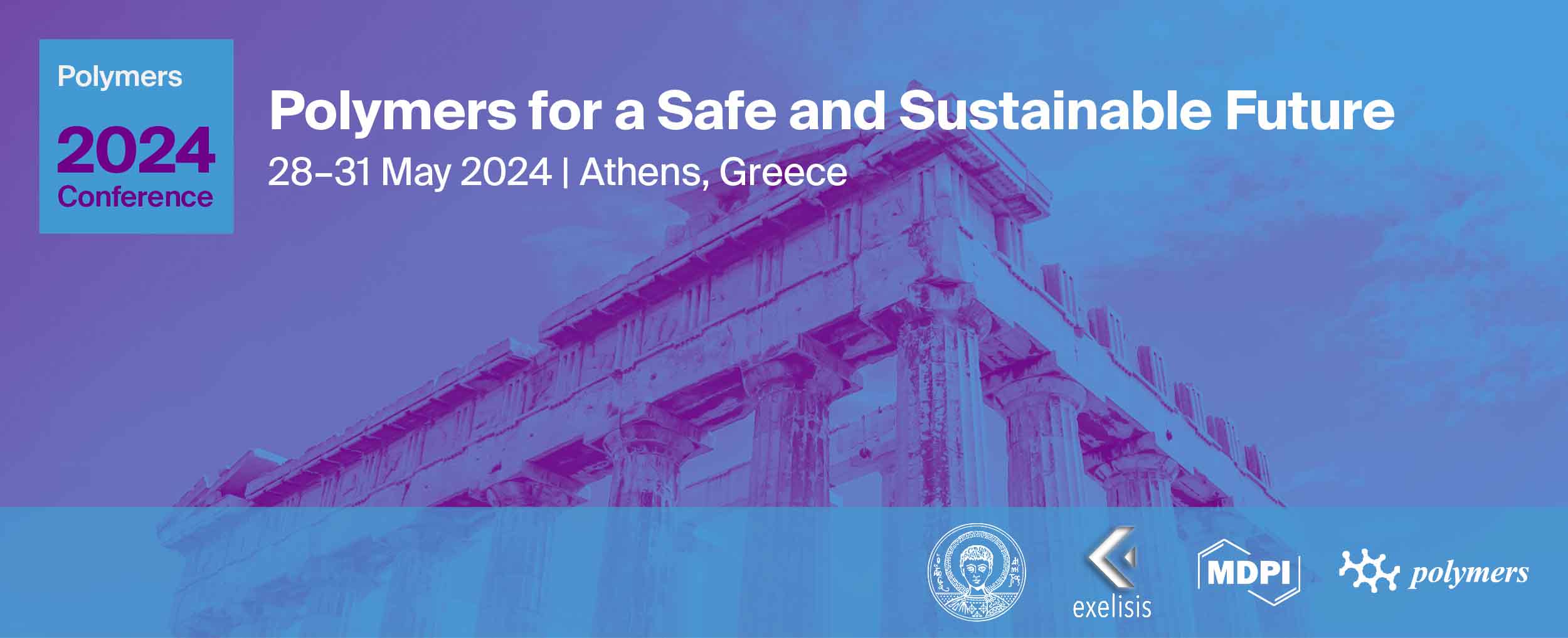-
 Short-Time Magnetron Sputtering for the Development of Carbon–Palladium Nanocomposites
Short-Time Magnetron Sputtering for the Development of Carbon–Palladium Nanocomposites -
 Photocatalysis Based on Metal Halide Perovskites for Organic Chemical Transformations
Photocatalysis Based on Metal Halide Perovskites for Organic Chemical Transformations -
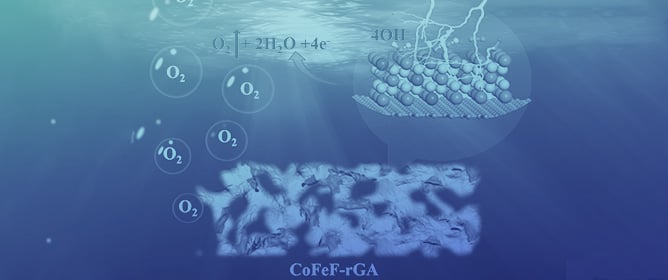 Graphene Architecture-Supported Porous Cobalt–Iron Fluoride Nanosheets for Promoting the Oxygen Evolution Reaction
Graphene Architecture-Supported Porous Cobalt–Iron Fluoride Nanosheets for Promoting the Oxygen Evolution Reaction -
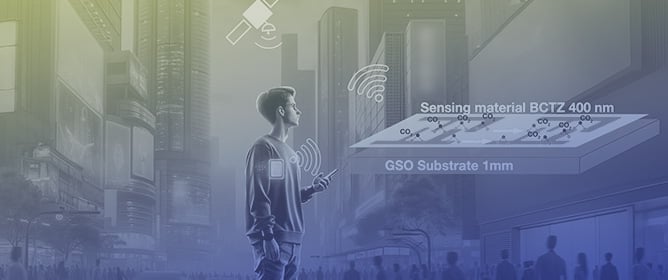 Lead-Free Perovskite Thin Films for Gas Sensing through Surface Acoustic Wave Device Detection
Lead-Free Perovskite Thin Films for Gas Sensing through Surface Acoustic Wave Device Detection -
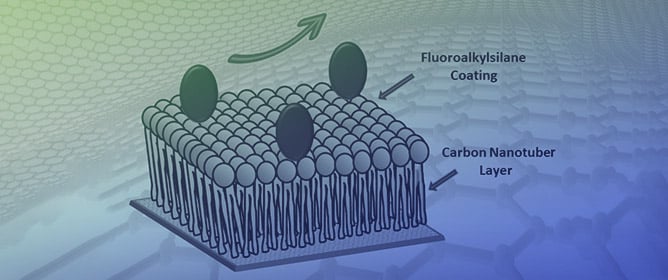 Development of a Carbon Nanotube-Enhanced FAS Bilayer Amphiphobic Coating for Biological Fluids
Development of a Carbon Nanotube-Enhanced FAS Bilayer Amphiphobic Coating for Biological Fluids
Journal Description
Nanomaterials
Nanomaterials
is an international, peer-reviewed, interdisciplinary scholarly open access journal, published semimonthly online by MDPI. It publishes reviews, regular research papers, communications, and short notes that are relevant to any field of study that involves nanomaterials, with respect to their science and application. The Spanish Carbon Group (GEC) is affiliated with Nanomaterials and their members receive discounts on the article processing charges.
- Open Access— free for readers, with article processing charges (APC) paid by authors or their institutions.
- High Visibility: indexed within Scopus, SCIE (Web of Science), PubMed, PMC, CAPlus / SciFinder, Inspec, and other databases.
- Journal Rank: JCR - Q1 (Physics, Applied) / CiteScore - Q1 (General Chemical Engineering)
- Rapid Publication: manuscripts are peer-reviewed and a first decision is provided to authors approximately 13.6 days after submission; acceptance to publication is undertaken in 2.5 days (median values for papers published in this journal in the second half of 2023).
- Recognition of Reviewers: reviewers who provide timely, thorough peer-review reports receive vouchers entitling them to a discount on the APC of their next publication in any MDPI journal, in appreciation of the work done.
- Companion journals for Nanomaterials include: Nanomanufacturing and Applied Nano.
Impact Factor:
5.3 (2022);
5-Year Impact Factor:
5.4 (2022)
Latest Articles
Na3MnTi(PO4)3/C Nanofiber Free-Standing Electrode for Long-Cycling-Life Sodium-Ion Batteries
Nanomaterials 2024, 14(9), 804; https://doi.org/10.3390/nano14090804 (registering DOI) - 05 May 2024
Abstract
Self-standing Na3MnTi(PO4)3/carbon nanofiber (CNF) electrodes are successfully synthesized by electrospinning. A pre-synthesized Na3MnTi(PO4)3 is dispersed in a polymeric solution, and the electrospun product is heat-treated at 750 °C in nitrogen flow to
[...] Read more.
Self-standing Na3MnTi(PO4)3/carbon nanofiber (CNF) electrodes are successfully synthesized by electrospinning. A pre-synthesized Na3MnTi(PO4)3 is dispersed in a polymeric solution, and the electrospun product is heat-treated at 750 °C in nitrogen flow to obtain active material/CNF electrodes. The active material loading is 10 wt%. SEM, TEM, and EDS analyses demonstrate that the Na3MnTi(PO4)3 particles are homogeneously spread into and within CNFs. The loaded Na3MnTi(PO4)3 displays the NASICON structure; compared to the pre-synthesized material, the higher sintering temperature (750 °C) used to obtain conductive CNFs leads to cell shrinkage along the a axis. The electrochemical performances are appealing compared to a tape-casted electrode appositely prepared. The self-standing electrode displays an initial discharge capacity of 124.38 mAh/g at 0.05C, completely recovered after cycling at an increasing C-rate and a coulombic efficiency ≥98%. The capacity value at 20C is 77.60 mAh/g, and the self-standing electrode exhibits good cycling performance and a capacity retention of 59.6% after 1000 cycles at 1C. Specific capacities of 33.6, 22.6, and 17.3 mAh/g are obtained by further cycling at 5C, 10C, and 20C, and the initial capacity is completely recovered after 1350 cycles. The promising capacity values and cycling performance are due to the easy electrolyte diffusion and contact with the active material, offered by the porous nature of non-woven nanofibers.
Full article
(This article belongs to the Special Issue Advances in Nanostructured Electrode Materials: Design and Applications)
►
Show Figures
Open AccessArticle
Optimize Electron Beam Energy toward In Situ Imaging of Thick Frozen Bio-Samples with Nanometer Resolution Using MeV-STEM
by
Xi Yang, Liguo Wang, Victor Smaluk and Timur Shaftan
Nanomaterials 2024, 14(9), 803; https://doi.org/10.3390/nano14090803 (registering DOI) - 05 May 2024
Abstract
To optimize electron energy for in situ imaging of large biological samples up to 10 μm in thickness with nanoscale resolutions, we implemented an analytical model based on elastic and inelastic characteristic angles. This model has been benchmarked by Monte Carlo simulations and
[...] Read more.
To optimize electron energy for in situ imaging of large biological samples up to 10 μm in thickness with nanoscale resolutions, we implemented an analytical model based on elastic and inelastic characteristic angles. This model has been benchmarked by Monte Carlo simulations and can be used to predict the transverse beam size broadening as a function of electron energy while the probe beam traverses through the sample. As a result, the optimal choice of the electron beam energy can be realized. In addition, the impact of the dose-limited resolution was analysed. While the sample thickness is less than 10 μm, there exists an optimal electron beam energy below 10 MeV regarding a specific sample thickness. However, for samples thicker than 10 μm, the optimal beam energy is 10 MeV or higher depending on the sample thickness, and the ultimate resolution could become worse with the increase in the sample thickness. Moreover, a MeV-STEM column based on a two-stage lens system can be applied to reduce the beam size from one micron at aperture to one nanometre at the sample with the energy tuning range from 3 to 10 MeV. In conjunction with the state-of-the-art ultralow emittance electron source that we recently implemented, the maximum size of an electron beam when it traverses through an up to 10 μm thick bio-sample can be kept less than
(This article belongs to the Special Issue The Interaction of Electron Phenomena on the Mesoscopic Scale)
►▼
Show Figures
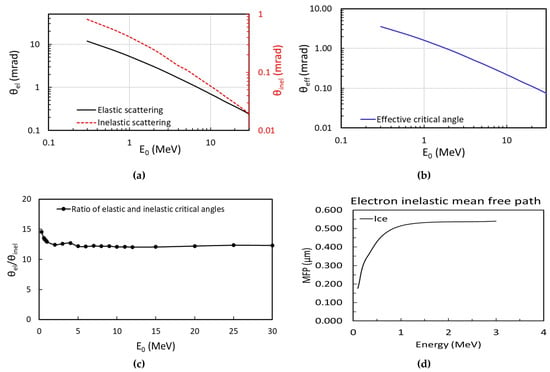
Figure 1
Open AccessArticle
Disinfectant-Assisted Preparation of Hierarchical ZSM-5 Zeolite with Excellent Catalytic Stabilities in Propane Aromatization
by
Peng Zhang, Jianguo Zhuang, Jisheng Yu, Yingjie Guan, Xuedong Zhu and Fan Yang
Nanomaterials 2024, 14(9), 802; https://doi.org/10.3390/nano14090802 (registering DOI) - 05 May 2024
Abstract
A series of quaternary ammonium or phosphonium salts were applied as zeolite growth modifiers in the synthesis of hierarchical ZSM-5 zeolite. The results showed that the use of methyltriphenylphosphonium bromide (MTBBP) could yield nano-sized hierarchical ZSM-5 zeolite with a “rice crust” morphology feature,
[...] Read more.
A series of quaternary ammonium or phosphonium salts were applied as zeolite growth modifiers in the synthesis of hierarchical ZSM-5 zeolite. The results showed that the use of methyltriphenylphosphonium bromide (MTBBP) could yield nano-sized hierarchical ZSM-5 zeolite with a “rice crust” morphology feature, which demonstrates a better catalytic performance than other disinfect candidates. It was confirmed that the addition of MTBBP did not cause discernable adverse effects on the microstructures or acidities of ZSM-5, but it led to the creation of abundant meso- to marco- pores as a result of aligned tiny particle aggregations. Moreover, the generation of the special morphology was believed to be a result of the coordination and competition between MTBBP and Na+ cations. The as-synthesized hierarchical zeolite was loaded with Zn and utilized in the propane aromatization reaction, which displayed a prolonged lifetime (1430 min vs. 290 min compared with conventional ZSM-5) and an enhanced total turnover number that is four folds of the traditional one, owing to the attenuated hydride transfer reaction and slow coking rate. This work provides a new method to alter the morphological properties of zeolites with low-cost disinfectants, which is of great potential for industrial applications.
Full article
(This article belongs to the Special Issue Nanostructured Materials for Carbon Neutrality)
Open AccessArticle
Study on Anomalous Hall Effect and Spin–Orbit Torque Effect of TbCo-Based Multilayer Films
by
Menglu Yang, Yuanjing Qu, Tao He, Xiong He, Yunli Xu, Lizhi Yi, Liqing Pan and Guangduo Lu
Nanomaterials 2024, 14(9), 801; https://doi.org/10.3390/nano14090801 (registering DOI) - 05 May 2024
Abstract
►▼
Show Figures
The anomalous Hall effect and spin–orbit torque of TbCo-based multilayer films have been methodically studied in recent years. Many properties of the films can be obtained by the anomalous Hall resistance loops of the samples. We report on the effects of a structure
[...] Read more.
The anomalous Hall effect and spin–orbit torque of TbCo-based multilayer films have been methodically studied in recent years. Many properties of the films can be obtained by the anomalous Hall resistance loops of the samples. We report on the effects of a structure composed of two heavy metals as the buffer layers on the anomalous Hall resistance loops of TbCo-based multilayers at different temperatures. The results showed that the coercivity increases dramatically with decreasing temperature, and the samples without perpendicular magnetic anisotropy at room temperature showed perpendicular magnetic anisotropy at low temperatures. We quantified the spin–orbit torque efficiency and Dzyaloshinskii–Moriya interaction effective field size of the films W/Pt/TbCo/Pt at room temperature by measuring the loop shift of anomalous Hall resistance. The results showed that the study of anomalous Hall resistance loops plays an important role in the study of spintronics, which can not only show the basic properties of the sample, but can also obtain other information about the sample through the shift of the loops.
Full article

Figure 1
Open AccessArticle
Physiochemical and Electrochemical Properties of a Heat-Treated Electrode for All-Iron Redox Flow Batteries
by
Nitika Devi, Jay N. Mishra, Prabhakar Singh and Yong-Song Chen
Nanomaterials 2024, 14(9), 800; https://doi.org/10.3390/nano14090800 (registering DOI) - 05 May 2024
Abstract
Iron redox flow batteries (IRFBs) are cost-efficient RFBs that have the potential to develop low-cost grid energy storage. Electrode kinetics are pivotal in defining the cycle life and energy efficiency of the battery. In this study, graphite felt (GF) is heat-treated at 400,
[...] Read more.
Iron redox flow batteries (IRFBs) are cost-efficient RFBs that have the potential to develop low-cost grid energy storage. Electrode kinetics are pivotal in defining the cycle life and energy efficiency of the battery. In this study, graphite felt (GF) is heat-treated at 400, 500 and 600 °C, and its physicochemical and electrochemical properties are studied using XPS, FESEM, Raman and cyclic voltammetry. Surface morphology and structural changes suggest that GF heat-treated at 500 °C for 6 h exhibits acceptable thermal stability while accessing the benefits of heat treatment. Specific capacitance was calculated for assessing the wettability and electrochemical properties of pristine and treated electrodes. The 600 °C GF has the highest specific capacitance of 34.8 Fg−1 at 100 mV s−1, but the 500 °C GF showed the best battery performance. The good battery performance of the 500 °C GF is attributed to the presence of oxygen functionalities and the absence of thermal degradation during heat treatment. The battery consisting of 500 °C GF electrodes offered the highest voltage efficiency of ~74%, Coulombic efficiency of ~94%, and energy efficiency of ~70% at 20 mA cm−2. Energy efficiency increased by 7% in a battery consisting of heat-treated GF in comparison to pristine GF. The battery is capable of operating for 100 charge–discharge cycles with an average energy efficiency of ~ 67% for over 100 cycles.
Full article
(This article belongs to the Section Energy and Catalysis)
►▼
Show Figures

Figure 1
Open AccessArticle
Terahertz Biosensor Engineering Based on Quasi-BIC Metasurface with Ultrasensitive Detection
by
Jun Peng, Xian Lin, Xiaona Yan, Xin Yan, Xiaofei Hu, Haiyun Yao, Lanju Liang and Guohong Ma
Nanomaterials 2024, 14(9), 799; https://doi.org/10.3390/nano14090799 (registering DOI) - 04 May 2024
Abstract
Terahertz (THz) sensors have attracted great attention in the biological field due to their nondestructive and contact-free biochemical samples. Recently, the concept of a quasi-bound state in the continuum (QBIC) has gained significant attention in designing biosensors with ultrahigh sensitivity. QBIC-based metasurfaces (MSs)
[...] Read more.
Terahertz (THz) sensors have attracted great attention in the biological field due to their nondestructive and contact-free biochemical samples. Recently, the concept of a quasi-bound state in the continuum (QBIC) has gained significant attention in designing biosensors with ultrahigh sensitivity. QBIC-based metasurfaces (MSs) achieve excellent performance in various applications, including sensing, optical switching, and laser, providing a reliable platform for biomaterial sensors with terahertz radiation. In this study, a structure-engineered THz MS consisting of a “double C” array has been designed, in which an asymmetry parameter α is introduced into the structure by changing the length of one subunit; the Q-factor of the QBIC device can be optimized by engineering the asymmetry parameter α. Theoretical calculation with coupling equations can well reproduce the THz transmission spectra of the designed THz QBIC MS obtained from the numerical simulation. Experimentally, we adopt an MS with α = 0.44 for testing arginine molecules. The experimental results show that different concentrations of arginine molecules lead to significant transmission changes near QBIC resonant frequencies, and the amplitude change is shown to be 16 times higher than that of the classical dipole resonance. The direct limit of detection for arginine molecules on the QBIC MS reaches 0.36 ng/mL. This work provides a new way to realize rapid, accurate, and nondestructive sensing of trace molecules and has potential application in biomaterial detection.
Full article
(This article belongs to the Special Issue Advances in Plasmonics, Metamaterials, Nanophotonics and Their Applications of Light Modulation and Detection)
►▼
Show Figures

Figure 1
Open AccessArticle
The Effects of Irradiation on the Improvement in Oxidation Behavior of MX-ODS Steel in Liquid Pb
by
Yuwen Xu, Shijing Xie, Jie Qiu, Cunfeng Yao, Wei Yan, Yanfen Li, Chongdou Yang, Shaoqiang Guo, Long Gu and Di Yun
Nanomaterials 2024, 14(9), 798; https://doi.org/10.3390/nano14090798 (registering DOI) - 04 May 2024
Abstract
►▼
Show Figures
Lead-cooled fast reactors exhibit strong inherent safety performance and good economic features, while material degradation due to corrosion and irradiation is still challenging. Oxide dispersion-strengthened steels are one of the promising candidates for fuel cladding materials. The effects of both irradiation and corrosion
[...] Read more.
Lead-cooled fast reactors exhibit strong inherent safety performance and good economic features, while material degradation due to corrosion and irradiation is still challenging. Oxide dispersion-strengthened steels are one of the promising candidates for fuel cladding materials. The effects of both irradiation and corrosion on ODS steel need to be further studied. In this work, MX-ODS steel was irradiated by Fe ions at 500 °C up to 46 dpa. Later, the as-received specimen and the irradiated specimen were used to conduct corrosion tests in oxygen-saturated Pb at 550 °C for 1 h. In the as-received specimen, discontinuous oxides penetrated by Pb and Pb in contact with steel matrix were observed, demonstrating unsatisfactory corrosion resistance of the material. However, in the irradiated specimen after corrosion experiment, a protective oxide layer formed and prevented Pb attack. The oxidation behavior differences between the two specimens can be attributed to the defects produced by irradiation and the structural discrepancy in oxides caused by the formation process. A possible mechanism of irradiation on the corrosion is discussed. In the as-received specimen, Fe atoms loss led to voids in the oxides, and lead penetrated the oxides through these voids. In the irradiated specimen, defects left by previous irradiation helped to form a more uniform oxide layer. The adhesive outer magnetite oxide and the Fe ions generated from where grain boundary oxidation developed retarded the presence of voids and made the oxide layer protective.
Full article
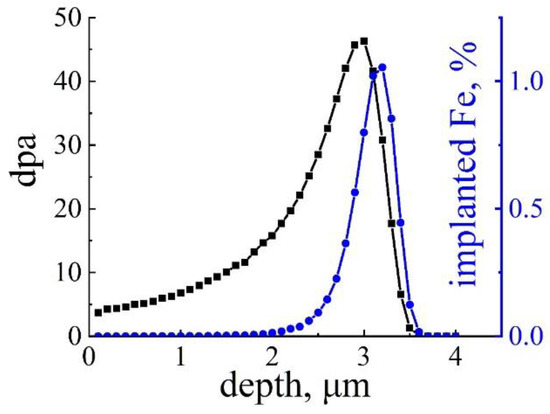
Figure 1
Open AccessReview
Metal–Organic Framework Nanomaterials as a Medicine for Catalytic Tumor Therapy: Recent Advances
by
Jiaojiao Zhang, Meiyu Li, Maosong Liu, Qian Yu, Dengfeng Ge and Jianming Zhang
Nanomaterials 2024, 14(9), 797; https://doi.org/10.3390/nano14090797 - 03 May 2024
Abstract
Nanomaterials, with unique physical, chemical, and biocompatible properties, have attracted significant attention as an emerging active platform in cancer diagnosis and treatment. Amongst them, metal–organic framework (MOF) nanostructures are particularly promising as a nanomedicine due to their exceptional surface functionalities, adsorption properties, and
[...] Read more.
Nanomaterials, with unique physical, chemical, and biocompatible properties, have attracted significant attention as an emerging active platform in cancer diagnosis and treatment. Amongst them, metal–organic framework (MOF) nanostructures are particularly promising as a nanomedicine due to their exceptional surface functionalities, adsorption properties, and organo-inorganic hybrid characteristics. Furthermore, when bioactive substances are integrated into the structure of MOFs, these materials can be used as anti-tumor agents with superior performance compared to traditional nanomaterials. In this review, we highlight the most recent advances in MOFs-based materials for tumor therapy, including their application in cancer treatment and the underlying mechanisms.
Full article
(This article belongs to the Special Issue Advances in Nanomaterials for Energy Conversion and Environmental Catalysis)
►▼
Show Figures
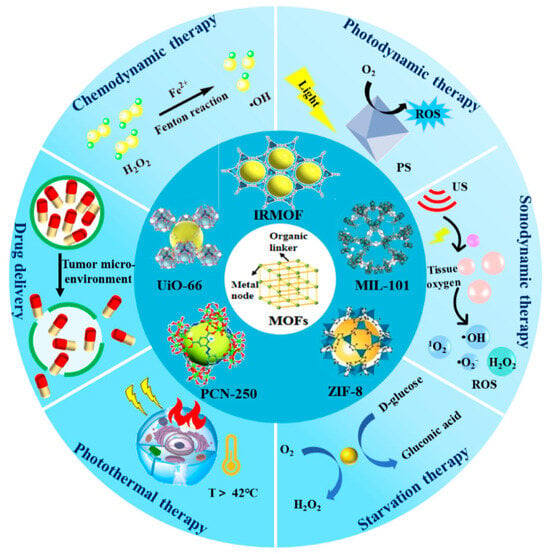
Figure 1
Open AccessArticle
Redox-Modified Nanostructured Electrochemical Surfaces for Continuous Glucose Monitoring in Complex Biological Fluids
by
Sajjad Janfaza, Nandhinee Radha Shanmugam, Pawan Jolly, Prashanthi Kovur, Upasana Singh, Scott Mackay, David Wishart and Donald E. Ingber
Nanomaterials 2024, 14(9), 796; https://doi.org/10.3390/nano14090796 - 03 May 2024
Abstract
►▼
Show Figures
Continuous glucose monitoring is valuable for people with diabetes but faces limitations due to enzyme–electrode interactions and biofouling from biological samples that reduce sensor sensitivity and the monitoring performance. We created an enzyme-based electrochemical system with a unique nanocomposite coating that incorporates the
[...] Read more.
Continuous glucose monitoring is valuable for people with diabetes but faces limitations due to enzyme–electrode interactions and biofouling from biological samples that reduce sensor sensitivity and the monitoring performance. We created an enzyme-based electrochemical system with a unique nanocomposite coating that incorporates the redox molecule, aminoferrocene (NH2-Fc). This coating enhances stability via electroactivity and reduces nonspecific binding, as demonstrated through cyclic voltammetry. Our approach enables real-time glucose detection via chronoamperometry with a calculated linear range of 0.5 to 20 mM and a 1 mM detection limit. Validated with plasma and saliva, this platform shows promise for robust metabolite detection in clinical and research contexts. This versatile platform can be applied to accurately monitor a wide range of metabolites in various biological matrices, improving patient outcomes.
Full article

Figure 1
Open AccessArticle
Super-Suppression of Long-Wavelength Phonons in Constricted Nanoporous Geometries
by
P. Alex Greaney, S. Aria Hosseini, Laura de Sousa Oliveira, Alathea Davies and Neophytos Neophytou
Nanomaterials 2024, 14(9), 795; https://doi.org/10.3390/nano14090795 - 03 May 2024
Abstract
In a typical semiconductor material, the majority of the heat is carried by long-wavelength, long-mean-free-path phonons. Nanostructuring strategies to reduce thermal conductivity, a promising direction in the field of thermoelectrics, place scattering centers of size and spatial separation comparable to the mean free
[...] Read more.
In a typical semiconductor material, the majority of the heat is carried by long-wavelength, long-mean-free-path phonons. Nanostructuring strategies to reduce thermal conductivity, a promising direction in the field of thermoelectrics, place scattering centers of size and spatial separation comparable to the mean free paths of the dominant phonons to selectively scatter them. The resultant thermal conductivity is in most cases well predicted using Matthiessen’s rule. In general, however, long-wavelength phonons are not as effectively scattered as the rest of the phonon spectrum. In this work, using large-scale molecular-dynamics simulations, non-equilibrium Green’s function simulations, and Monte Carlo simulations, we show that specific nanoporous geometries that create narrow constrictions in the passage of phonons lead to anticorrelated heat currents in the phonon spectrum. This effect results in super-suppression of long-wavelength phonons due to heat trapping and reductions in the thermal conductivity to values well below those predicted by Matthiessen’s rule.
Full article
(This article belongs to the Special Issue Nanoscale Heat Transfer Phenomena: Ballisticity, Rectification, Collective Modes, Thermohydrodynamics, Coherence)
►▼
Show Figures

Figure 1
Open AccessFeature PaperArticle
CdSe/ZnS Quantum Rods (QRs) and Phenyl Boronic Acid BODIPY as Efficient Förster Resonance Energy Transfer (FRET) Donor–Acceptor Pair
by
Gianluca Salerno, Pasquale Palladino, Marcello Marelli, Laura Polito, Maria Minunni, Debora Berti, Simona Scarano, Giacomo Biagiotti and Barbara Richichi
Nanomaterials 2024, 14(9), 794; https://doi.org/10.3390/nano14090794 - 03 May 2024
Abstract
►▼
Show Figures
The reversibility of the covalent interaction between boronic acids and 1,2- or 1,3-diols has put the spotlight on this reaction for its potential in the development of sensors and for the fishing of bioactive glycoconjugates. In this work, we describe the investigation of
[...] Read more.
The reversibility of the covalent interaction between boronic acids and 1,2- or 1,3-diols has put the spotlight on this reaction for its potential in the development of sensors and for the fishing of bioactive glycoconjugates. In this work, we describe the investigation of this reaction for the reversible functionalization of the surface of CdSe/ZnS Quantum Rods (QRs). With this in mind, we have designed a turn-off Förster resonance energy transfer (FRET) system that ensures monitoring the extent of the reaction between the phenyl boronic residue at the meso position of a BODIPY probe and the solvent-exposed 1,2-diols on QRs’ surface. The reversibility of the corresponding boronate ester under oxidant conditions has also been assessed, thus envisioning the potential sensing ability of this system.
Full article
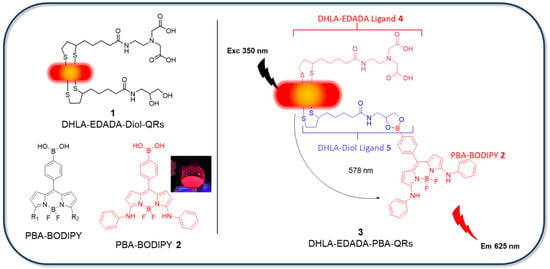
Figure 1
Open AccessArticle
Electrochemical Sensing Device for Carboplatin Monitoring in Proof-of-Concept Drug Delivery Nanosystems
by
Alexandra Pusta, Mihaela Tertis, Catalina Ardusadan, Simona Mirel and Cecilia Cristea
Nanomaterials 2024, 14(9), 793; https://doi.org/10.3390/nano14090793 - 02 May 2024
Abstract
(1) Background: Carboplatin (CBP) is a chemotherapeutic drug widely used in the treatment of a variety of cancers. Despite its efficiency, CBP is associated with side effects that greatly limit its clinical use. To mitigate these effects, CBP can be encapsulated in targeted
[...] Read more.
(1) Background: Carboplatin (CBP) is a chemotherapeutic drug widely used in the treatment of a variety of cancers. Despite its efficiency, CBP is associated with side effects that greatly limit its clinical use. To mitigate these effects, CBP can be encapsulated in targeted delivery systems, such as liposomes. Ensuring the adequate loading and release of CBP from these carriers requires strict control in pharmaceutical formulation development, demanding modern, rapid, and robust analytical methods. The aim of this study was the development of a sensor for the fast and accurate quantification of CBP and its application on proof-of-concept CBP-loaded nanosomes. (2) Methods: Screen-printed electrodes were obtained in-lab and the electrochemical behavior of CBP was tested on the obtained electrodes. (3) Results: The in-lab screen-printed electrodes demonstrated superior properties compared to commercial ones. The novel sensors demonstrated accurate detection of CBP on a dynamic range from 5 to 500 μg/mL (13.5–1350 μM). The method was successfully applied on CBP loaded and released from nanosomes, with strong correlations with a spectrophotometric method used as control. (4) Conclusions: This study demonstrates the viability of electrochemical techniques as alternative options during the initial phases of pharmaceutical formulation development.
Full article
(This article belongs to the Special Issue Trends in Electrochemical Nanosensing)
►▼
Show Figures

Figure 1
Open AccessArticle
Heat-Annealed Zinc Oxide on Flexible Carbon Nanotube Paper and Exposed to Gradient Light to Enhance Its Photoelectric Response
by
Jih-Hsin Liu and Pi-Yu Shen
Nanomaterials 2024, 14(9), 792; https://doi.org/10.3390/nano14090792 - 02 May 2024
Abstract
Buckypaper (BP), a flexible and porous material, exhibits photovoltaic properties when exposed to light. In this study, we employed radio frequency (RF) sputtering of zinc oxide (ZnO) followed by rapid thermal annealing to enhance the photovoltaic response of BP. We investigated the impact
[...] Read more.
Buckypaper (BP), a flexible and porous material, exhibits photovoltaic properties when exposed to light. In this study, we employed radio frequency (RF) sputtering of zinc oxide (ZnO) followed by rapid thermal annealing to enhance the photovoltaic response of BP. We investigated the impact of various sputtering parameters, such as the gas flow ratio of argon to oxygen and deposition time, on the morphology, composition, resistivity, and photovoltaic characteristics of ZnO-modified BP. Additionally, the photovoltaic performance of the samples under different illumination modes and wavelengths was compared. It was found that optimal sputtering conditions—argon to oxygen flow ratio of 1:2, deposition time of 20 min, and power of 100 watts—resulted in a ZnO film thickness of approximately 45 nanometers. After annealing at 400 °C for 10 min, the ZnO-modified BP demonstrated a significant increase in photocurrent and photovoltage, along with a reduction in resistivity, compared to unmodified BP. Moreover, under gradient illumination, the ZnO-modified BP exhibited a photovoltage enhancement of 14.70-fold and a photocurrent increase of 13.86-fold, compared to uniform illumination. Under blue light, it showed a higher photovoltaic response than under other colors. The enhancement in photovoltaic response is attributed to the formation of a Schottky junction between ZnO and BP, an increased carrier concentration gradient, and an expanded light absorption spectrum. Our results validate that ZnO sputtering followed by annealing is an effective method for modifying BP for photovoltaic applications such as solar cells and photodetectors.
Full article
(This article belongs to the Special Issue Growth, Characterization and Applications of Nanotubes: Volume II)
►▼
Show Figures

Figure 1
Open AccessArticle
UV/Ozone-Treated and Sol–Gel-Processed Y2O3 Insulators Prepared Using Gelation-Delaying Precursors
by
Sangwoo Lee, Yoonjin Cho, Seongwon Heo, Jin-Hyuk Bae, In-Man Kang, Kwangeun Kim, Won-Yong Lee and Jaewon Jang
Nanomaterials 2024, 14(9), 791; https://doi.org/10.3390/nano14090791 - 01 May 2024
Abstract
In this study, a Y2O3 insulator was fabricated via the sol–gel process and the effect of precursors and annealing processes on its electrical performance was studied. Yttrium(III) acetate hydrate, yttrium(III) nitrate tetrahydrate, yttrium isopropoxide oxide, and yttrium(III) tris (isopropoxide) were
[...] Read more.
In this study, a Y2O3 insulator was fabricated via the sol–gel process and the effect of precursors and annealing processes on its electrical performance was studied. Yttrium(III) acetate hydrate, yttrium(III) nitrate tetrahydrate, yttrium isopropoxide oxide, and yttrium(III) tris (isopropoxide) were used as precursors, and UV/ozone treatment and high-temperature annealing were performed to obtain Y2O3 films from the precursors. The structure and surface morphologies of the films were characterized via grazing-incidence X-ray diffraction and scanning probe microscopy. Chemical component analysis was performed via X-ray spectroscopy. Electrical insulator characteristics were analyzed based on current density versus electrical field data and frequency-dependent dielectric constants. The Y2O3 films fabricated using the acetate precursor and subjected to the UV/ozone treatment showed a uniform and flat surface morphology with the lowest number of oxygen vacancy defects and unwanted byproducts. The corresponding fabricated capacitors showed the lowest current density (Jg) value of 10−8 A/cm2 at 1 MV/cm and a stable dielectric constant in a frequency range of 20 Hz–100 KHz. At 20 Hz, the dielectric constant was 12.28, which decreased to 10.5 at 105 Hz. The results indicate that high-quality, high-k insulators can be fabricated for flexible electronics using suitable precursors and the suggested low-temperature fabrication methods.
Full article
(This article belongs to the Special Issue Nano-Structured Thin Films: Growth, Characteristics, and Application)
►▼
Show Figures
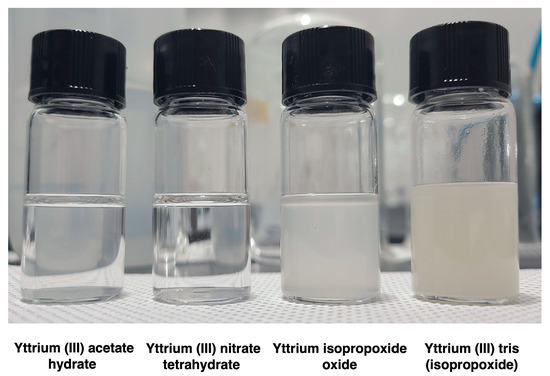
Figure 1
Open AccessArticle
Klein Tunneling in β12 Borophene
by
Jinhao Lai, Lekang Wang, Fu Li, Hongbin Zhang and Qingtian Zhang
Nanomaterials 2024, 14(9), 790; https://doi.org/10.3390/nano14090790 - 01 May 2024
Abstract
►▼
Show Figures
Motivated by the recent observation of Klein tunneling in 8-Pmmn borophene, we delve into the phenomenon in β12 borophene by employing tight-binding approximation theory to establish a theoretical mode. The tight-binding model is a semi-empirical method for establishing the Hamiltonian based on
[...] Read more.
Motivated by the recent observation of Klein tunneling in 8-Pmmn borophene, we delve into the phenomenon in β12 borophene by employing tight-binding approximation theory to establish a theoretical mode. The tight-binding model is a semi-empirical method for establishing the Hamiltonian based on atomic orbitals. A single cell of β12 borophene contains five atoms and multiple central bonds, so it creates the complexity of the tight-binding model Hamiltonian of β12 borophene. We investigate transmission across one potential barrier and two potential barriers by changing the width and height of barriers and the distance between two potential barriers. Regardless of the change in the barrier heights and widths, we find the interface to be perfectly transparent for normal incidence. For other angles of incidence, perfect transmission at certain angles can also be observed. Furthermore, perfect and all-angle transmission across a potential barrier takes place when the incident energy approaches the Dirac point. This is analogous to the “super”, all-angle transmission reported for the dice lattice for Klein tunneling across a potential barrier. These findings highlight the significance of our theoretical model in understanding the complex dynamics of Klein tunneling in borophene structures.
Full article
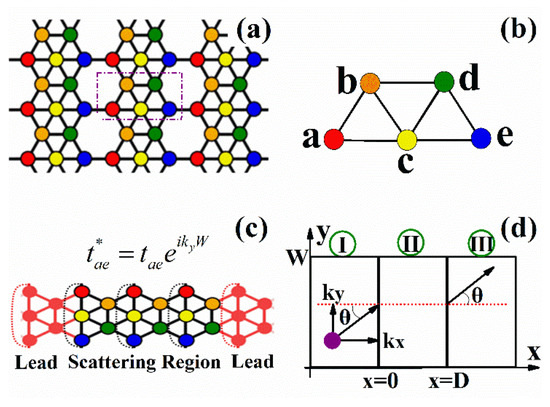
Figure 1
Open AccessArticle
Simultaneous Detection of Carbon Quantum Dots as Tracers for Interwell Connectivity Evaluation in a Pattern with Two Injection Wells
by
Stephania Rosales, Karol Zapata, Farid B. Cortes, Benjamín Rojano, Carlos Diaz, Carlos Cortes, David Jaramillo, Adriana Vasquez, Diego Ramirez and Camilo A. Franco
Nanomaterials 2024, 14(9), 789; https://doi.org/10.3390/nano14090789 - 01 May 2024
Abstract
►▼
Show Figures
This study aimed to develop and implement a nanotechnology-based alternative to traditional tracers used in the oil and gas industry for assessing interwell connectivity. A simple and rapid hydrothermal protocol for synthesizing carbon quantum dots (CQDs) using agroindustry waste was implemented. Three commercial
[...] Read more.
This study aimed to develop and implement a nanotechnology-based alternative to traditional tracers used in the oil and gas industry for assessing interwell connectivity. A simple and rapid hydrothermal protocol for synthesizing carbon quantum dots (CQDs) using agroindustry waste was implemented. Three commercial CQDs were employed (CQDblue, CQDgreen, and CQDred); the fourth was synthesized from orange peel (CQDop). The CQDs from waste and other commercials with spherical morphology, nanometric sizes less than 11 nm in diameter, and surface roughness less than 3.1 nm were used. These tracers demonstrated high colloidal stability with a negative zeta potential, containing carbonyl-type chemical groups and unsaturations in aromatic structures that influenced their optical behavior. All materials presented high colloidal stability with negative values of charge z potential between −17.8 and −49.1. Additionally, individual quantification of these tracers is feasible even in scenarios where multiple CQDs are present in the effluent with a maximum percentage of interference of 15.5% for CQDop in the presence of the other three nanotracers. The CQDs were injected into the field once the technology was insured under laboratory conditions. Monitoring the effluents allowed the determination of connectivity for five first-line producer wells. This study enables the application of CQDs in the industry, particularly in fields where the arrangement of injector and producer wells is intricate, requiring the use of multiple tracers for a comprehensive description of the system.
Full article
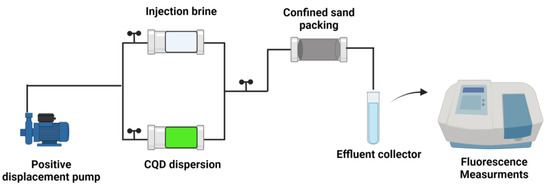
Figure 1
Open AccessArticle
Hydrogenation of Furfural over Biomass-Based Electron-Deficient Co-NC Nanotube Catalyst
by
Zhu Zhu and Guangyue Xu
Nanomaterials 2024, 14(9), 788; https://doi.org/10.3390/nano14090788 - 01 May 2024
Abstract
The conversion of furfural to furfuryl alcohol is one of the most significant reactions from industrial-scale produced biomass platform molecules to value-added chemicals. In this work, biomass-based chitosan was used as both a carbon source and nitrogen source to synthesize nitrogen-doped carbon. With
[...] Read more.
The conversion of furfural to furfuryl alcohol is one of the most significant reactions from industrial-scale produced biomass platform molecules to value-added chemicals. In this work, biomass-based chitosan was used as both a carbon source and nitrogen source to synthesize nitrogen-doped carbon. With the addition of cobalt, the optimized 7.5Co-NC-900 catalyst had the largest surface area and the graphite nanotube structure with the least defects. It was employed for the hydrogenation of furfural to furfuryl alcohol and reached a nearly full conversion and an equivalent yield at 130 °C in 4 MPa initial H2. The structure–function relationship study indicated that the N could interact with the neighbor Co in this catalyst and formed an electron-deficient Co center which was in favor of the adsorption of furfural in the nanotube and had high catalytic activity. The interactions between Co and N stabilized the catalyst so that it could remain stable in five runs of catalytic reactions.
Full article
(This article belongs to the Special Issue Catalytic Nanomaterials for Environmental Protection and Sustainable Development)
►▼
Show Figures
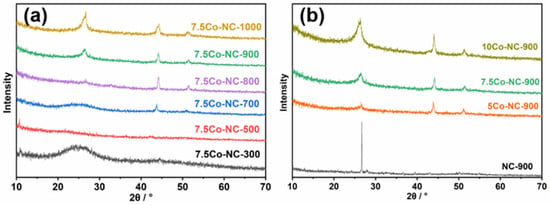
Figure 1
Open AccessCommunication
Adjoint Algorithm Design of Selective Mode Reflecting Metastructure for BAL Applications
by
Zean Li, Xunyu Zhang, Cheng Qiu, Yingshuai Xu, Zhipeng Zhou, Ziyuan Wei, Yiman Qiao, Yongyi Chen, Yubing Wang, Lei Liang, Yuxin Lei, Yue Song, Peng Jia, Yugang Zeng, Li Qin, Yongqiang Ning and Lijun Wang
Nanomaterials 2024, 14(9), 787; https://doi.org/10.3390/nano14090787 - 01 May 2024
Abstract
Broad-area lasers (BALs) have found applications in a variety of crucial fields on account of their high output power and high energy transfer efficiency. However, they suffer from poor spatial beam quality due to multi-mode behavior along the waveguide transverse direction. In this
[...] Read more.
Broad-area lasers (BALs) have found applications in a variety of crucial fields on account of their high output power and high energy transfer efficiency. However, they suffer from poor spatial beam quality due to multi-mode behavior along the waveguide transverse direction. In this paper, we propose a novel metasurface waveguide structure acting as a transverse mode selective back-reflector for BALs. In order to effectively inverse design such a structure, a digital adjoint algorithm is introduced to adapt the considerably large design area and the high degree of freedom. As a proof of the concept, a device structure with a design area of 40 × 20 μm2 is investigated. The simulation results exhibit high fundamental mode reflection (above 90%), while higher-order transverse mode reflections are suppressed below 0.2%. This is, to our knowledge, the largest device structure designed based on the inverse method. We exploited such a device and the method and further investigated the device’s robustness and feasibility of the inverse method. The results are elaborately discussed.
Full article
(This article belongs to the Section Theory and Simulation of Nanostructures)
►▼
Show Figures
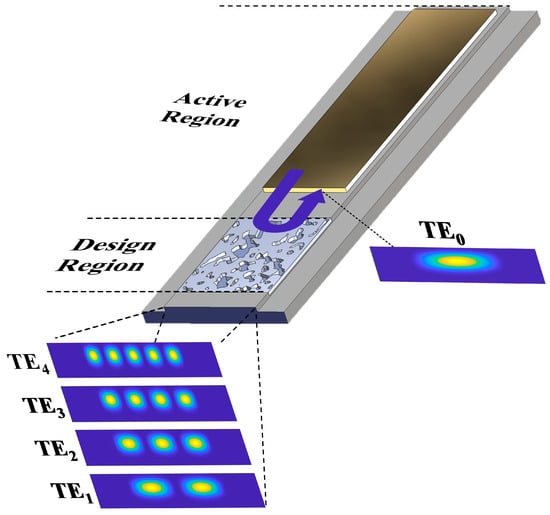
Figure 1
Open AccessArticle
Enhancement of Peroxydisulfate Activation for Complete Degradation of Refractory Tetracycline by 3D Self-Supported MoS2/MXene Nanocomplex
by
Yuxia Song, Runhua Chen, Shihai Li, Shali Yu, Xiaoli Ni, Minglong Fang and Hanyun Xie
Nanomaterials 2024, 14(9), 786; https://doi.org/10.3390/nano14090786 - 30 Apr 2024
Abstract
Antibiotic abuse, particularly the excessive use of tetracycline (TC), a drug with significant environmental risk, has gravely harmed natural water bodies and even posed danger to human health. In this study, a three-dimensional self-supported MoS2/MXene nanohybrid with an expanded layer spacing
[...] Read more.
Antibiotic abuse, particularly the excessive use of tetracycline (TC), a drug with significant environmental risk, has gravely harmed natural water bodies and even posed danger to human health. In this study, a three-dimensional self-supported MoS2/MXene nanohybrid with an expanded layer spacing was synthesized via a facile one-step hydrothermal method and used to activate peroxydisulfate (PDS) for the complete degradation of TC. The results showed that a stronger •OH signal was detected in the aqueous solution containing MoS2/MXene, demonstrating a superior PDS activation effect compared to MoS2 or Ti3C2TX MXene alone. Under the conditions of a catalyst dosage of 0.4 g/L, a PDS concentration of 0.4 mM, and pH = 5.0, the MoS2/MXene/PDS system was able to fully eliminate TC within one hour, which was probably due to the presence of several reactive oxygen species (ROS) (•OH, SO4•−, and O2•−) in the system. The high TC degradation efficiency could be maintained under the influence of various interfering ions and after five cycles, indicating that MoS2/MXene has good anti-interference and reusability performance. Furthermore, the possible degradation pathways were proposed by combining liquid chromatography–mass spectrometry (LC-MS) data and other findings, and the mechanism of the MoS2/MXene/PDS system on the degradation process of TC was elucidated by deducing the possible mechanism of ROS generation in the reaction process. All of these findings suggest that the MoS2/MXene composite catalyst has strong antibiotic removal capabilities with a wide range of application prospects.
Full article
(This article belongs to the Special Issue Recent Advances and Research on Nanomaterials and Their Applications in Wastewater Treatment)
►▼
Show Figures

Figure 1
Open AccessArticle
Pyroclastic Dust from Arequipa-Peru Decorated with Iron Oxide Nanoparticles and Their Ecotoxicological Properties in Water Flea D. magna
by
Juan A. Ramos-Guivar, Yacu V. Alca-Ramos, Erich V. Manrique-Castillo, F. Mendoza-Villa, Noemi-Raquel Checca-Huaman, Renzo Rueda-Vellasmin and Edson C. Passamani
Nanomaterials 2024, 14(9), 785; https://doi.org/10.3390/nano14090785 - 30 Apr 2024
Abstract
A novel magnetic composite made of Peruvian pyroclastic dust material decorated with maghemite nanoparticles was synthesized and characterized using a variety of analytic techniques. The 13 nm maghemite nanoparticles were grown on the pyroclastic dust using the conventional coprecipitation chemical route. A short-term
[...] Read more.
A novel magnetic composite made of Peruvian pyroclastic dust material decorated with maghemite nanoparticles was synthesized and characterized using a variety of analytic techniques. The 13 nm maghemite nanoparticles were grown on the pyroclastic dust using the conventional coprecipitation chemical route. A short-term acute assay was developed to study the ecotoxicological behavior of the water flea, Daphnia magna. A 24 h-lethal concentration (LC50) value equal to 123.6 mg L−1 was determined only for the magnetic composite. While the pyroclastic dust material did not exhibit a lethal concentration, it caused morphologically significant changes (p < 0.05) for heart and tail parameters at high concentrations. Morphologies exposed to the magnetic composite above the 24 h-LC50 revealed less tolerance and significant changes in the body, heart, antenna, and eye. Hence, it affects biomarker growth and swimming. The reproduction rate was not affected by the raw pyroclastic dust material. However, the number of individuals showed a decrease with increasing composite concentrations. The present study indicates the LC50 value, which can be used as a reference concentration for in-situ water cleaning with this material without damaging or changing the Daphnia magna ecosystem.
Full article
(This article belongs to the Special Issue Toxicity of Engineered Nanomaterials: Current Understanding and Challenges)
►▼
Show Figures

Figure 1

Journal Menu
► ▼ Journal Menu-
- Nanomaterials Home
- Aims & Scope
- Editorial Board
- Reviewer Board
- Topical Advisory Panel
- Instructions for Authors
- Special Issues
- Topics
- Sections & Collections
- Article Processing Charge
- Indexing & Archiving
- Editor’s Choice Articles
- Most Cited & Viewed
- Journal Statistics
- Journal History
- Journal Awards
- Society Collaborations
- Conferences
- Editorial Office
Journal Browser
► ▼ Journal BrowserHighly Accessed Articles
Latest Books
E-Mail Alert
News
Topics
Topic in
Nanomaterials, Physics, Universe
Condensed Matter Physics and Catalysis
Topic Editors: Dongwei Ma, Peng LvDeadline: 9 May 2024
Topic in
Materials, Nanomaterials, Photonics, Polymers, Applied Sciences, Sensors
Optical and Optoelectronic Properties of Materials and Their Applications
Topic Editors: Zhiping Luo, Gibin George, Navadeep ShrivastavaDeadline: 20 May 2024
Topic in
Biomedicines, Cancers, JFB, Nanomaterials, Polymers
Advanced Functional Materials for Regenerative Medicine
Topic Editors: Antonino Morabito, Luca ValentiniDeadline: 6 June 2024
Topic in
Cancers, Cells, JCM, Radiation, Pharmaceutics, Applied Sciences, Nanomaterials, Current Oncology
Innovative Radiation Therapies
Topic Editors: Gérard Baldacchino, Eric Deutsch, Marie Dutreix, Sandrine Lacombe, Erika Porcel, Charlotte Robert, Emmanuelle Bourneuf, João Santos Sousa, Aurélien de la LandeDeadline: 30 June 2024

Conferences
Special Issues
Special Issue in
Nanomaterials
Nano-Photonics and Meta-Nanomaterials
Guest Editor: Suchand SandeepDeadline: 10 May 2024
Special Issue in
Nanomaterials
Applications of Nanomaterials in Biomedical Imaging and Cancer Therapy II
Guest Editor: James ChowDeadline: 20 May 2024
Special Issue in
Nanomaterials
Hierarchical Nanostructured Materials for Multifunctional Applications
Guest Editor: Xusheng DuDeadline: 31 May 2024
Special Issue in
Nanomaterials
Transmission Electron Microscopy for Nanomaterials Research Advances
Guest Editors: Antonietta Taurino, Elvio CarlinoDeadline: 10 June 2024
Topical Collections
Topical Collection in
Nanomaterials
Process Intensification, Process Design and Green Techniques for Nanomaterials Production and Applications
Collection Editors: Marco Stoller, Giorgio Vilardi
Topical Collection in
Nanomaterials
Magnetic Nanostructured Materials: Synthesis, Characterization and Their Cutting-Edge Applications
Collection Editors: Vasileios Tzitzios, Georgia Basina
Topical Collection in
Nanomaterials
The Fourth State of Engineering: Nanoengineered Materials and Coatings Facilitated by Plasma Techniques
Collection Editors: Krasimir Vasilev, Kostya (Ken) Ostrikov, Thomas Michl, Akash Bachhuka
Topical Collection in
Nanomaterials
Nanoarchitectonics of the Fourth Fundamental Electronic Component: Memristor, Meminductor and Memcapacitor
Collection Editors: Firman Simanjuntak, Yao-Feng Chang, Sridhar Chandrasekaran





